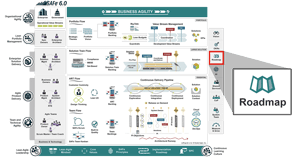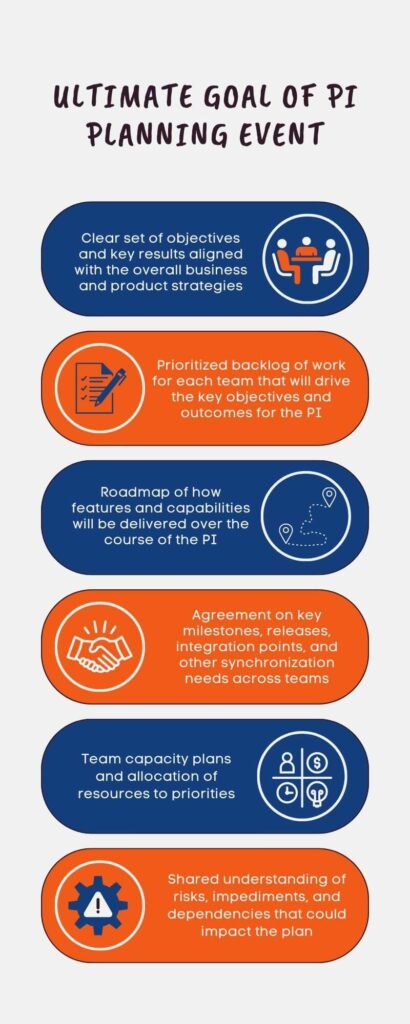PI (Program Increment) Planning is a significant event in the Agile framework that sets the tone for the upcoming development cycle. But what is the ultimate goal of the PI Planning event? This comprehensive guide aims to delve into the core purpose of PI Planning, unveiling its crucial objectives and outcomes. Understanding the ultimate goal of this event is essential for organizations looking to streamline their planning processes, align cross-functional teams, and ultimately deliver value to their customers. Join us as we explore the intricacies of the PI Planning event and how it contributes to the success of Agile projects and the overall organizational goals.
Understanding PI Planning
PI (Program Increment) Planning is a critical event in the context of Agile frameworks like SAFe (Scaled Agile Framework). Its ultimate goal is to align all teams around a shared mission and vision for the upcoming Program Increment. This event ensures that everyone is on the same page regarding the priorities, timelines, and dependencies.
Importance of PI Planning
PI Planning sets the foundation for the successful execution of the Program Increment. It allows teams to collaborate, communicate, and identify risks early on, thus minimizing roadblocks during the development cycle. Additionally, it fosters a sense of shared ownership and accountability.
Key Activities in PI Planning
During PI Planning, teams participate in various activities such as story mapping, estimating effort, sequencing work, and identifying dependencies. These exercises help in creating a realistic plan that aligns with the overall objectives.
- Story Mapping: Collaboratively define features and user stories.
- Estimating Effort: Assign relative effort points to stories for prioritization.
- Sequencing Work: Determine the order in which stories will be developed.
- Identifying Dependencies: Highlight any cross-team dependencies that need to be addressed.

Importance of PI Planning Event
PI (Program Increment) Planning Event is a crucial gathering for Agile teams aiming to align on goals, prioritize work, and synchronize activities. This event typically occurs every 8-12 weeks for Agile Release Trains (ARTs) to plan and coordinate their work in a structured manner.
Enhanced Alignment and Collaboration
PI Planning brings together all team members, product owners, stakeholders, and leaders to ensure everyone is on the same page regarding the objectives and priorities for the upcoming PI. This alignment enhances collaboration and fosters a shared understanding of the roadmap.
Facilitates Prioritization and Dependency Management
During the PI Planning Event, teams break down features, prioritize backlog items, and identify dependencies. This detailed planning helps in managing dependencies effectively, resolving conflicts, and ensuring that work is sequenced optimally to achieve the desired outcomes.
Image source: Unsplash
Key Components of PI Planning Event
PI Planning Event is a crucial gathering for Agile teams to align on priorities and plan for the upcoming Program Increment. It consists of several key components that contribute to its success.
Preparation Phase
The preparation phase involves setting objectives, inviting stakeholders, and ensuring all team members understand the goals and expectations for the event.
Teams collaborate to prepare their drafts and come fully prepared for the planning activities.
PI Planning Sessions
During the PI Planning sessions, teams engage in collaborative planning, breaking down features into stories and estimating the work required.
- Business context: Teams understand the market trends and customer needs to align their plans accordingly.
- Feature identification: Teams identify features to be developed during the PI based on business priorities.
- Dependency identification: Recognizing and managing dependencies is crucial for successful planning.
- Risk assessment: Teams identify risks and potential mitigation strategies to address uncertainties.

Establishing the Ultimate Goal
When considering the ultimate goal of the PI Planning event, it is essential to focus on aligning all team members towards a common objective that drives value and ensures successful outcomes. The primary aim of the PI Planning event is to bring together multiple Agile teams to collaborate, plan, and prioritize work for the upcoming Program Increment (PI).
Enhancing Cross-Team Collaboration
One of the key objectives of the PI Planning event is to enhance cross-team collaboration. By fostering communication and cooperation among various teams within the organization, the event aims to break down silos and promote a unified approach towards achieving shared goals.
This collaboration is crucial in enabling teams to understand dependencies, address conflicts, and collectively work towards the successful delivery of features and products.
Setting Clear Objectives and Priorities
Another important goal of the PI Planning event is to set clear objectives and priorities for the upcoming Program Increment. During the event, teams define and discuss the features and user stories that need to be delivered, prioritize them based on business value, and establish realistic timelines for implementation.
This process helps teams align their efforts with the overall strategic direction of the organization and ensures that everyone is working towards achieving the same desired outcomes.

Benefits of Achieving the Ultimate Goal
Reaching the ultimate goal of the PI (Program Increment) Planning event brings numerous benefits that significantly impact the success of the project and team collaboration. By understanding what the ultimate goal of the PI Planning event is, teams can align their efforts more effectively towards a common objective.
Enhanced Team Alignment
When the ultimate goal of the PI Planning event is achieved, teams experience a higher level of alignment in terms of priorities, timelines, and dependencies. This alignment fosters better communication and coordination among team members, leading to smoother project execution.
Additionally, collaboration within and across teams is strengthened, creating a more cohesive working environment.
Increased Productivity and Efficiency
By focusing on and achieving the ultimate goal of the PI Planning event, teams can streamline their processes and eliminate inefficiencies. This optimization results in improved productivity as teams work towards a common objective with a clear roadmap in place.
- Enhanced task prioritization
- Reduced waste in development processes
Steps to Successfully Execute the PI Planning Event
Organizing a successful PI Planning Event is crucial for ensuring alignment and synchronization across teams in an Agile environment. Here are some key steps to help you execute the event effectively:
1. Preparation Phase
In this phase, create a clear agenda detailing the objectives, timelines, and expectations for the event. Ensure that all necessary stakeholders are informed well in advance.
It is essential to establish communication channels for sharing pre-reading materials and setting up the virtual environment if the event is conducted remotely.
2. Facilitation and Execution
During the event, the facilitator plays a key role in guiding the teams through the agenda, timeboxing activities, and encouraging active participation.
- Start with a kick-off to set the context and build enthusiasm among participants. Encourage open communication and collaboration throughout the planning sessions.
- Emphasize the importance of prioritization, identifying dependencies, and resolving conflicts in real-time to ensure a successful planning outcome.
Best Practices for Maximizing the Impact of PI Planning
PI Planning events aim to align teams, enhance collaboration, and set clear objectives for the coming Program Increment. To maximize the impact of PI Planning, consider the following strategies:
Establish Clear Objectives
Define the ultimate goal of the PI Planning event clearly. Ensure all teams and stakeholders are aligned on the objectives to drive focused discussions.
Encourage Open Communication
Promote open dialogue among teams to share insights, dependencies, and challenges. Foster a collaborative environment to address bottlenecks effectively.
Utilize Visual Aids
Visualize the PI Planning process using tools like whiteboards, charts, or digital platforms. Visual aids enhance understanding and facilitate decision-making.
Allocate Sufficient Time
Ensure ample time for discussions, refinement, and decision-making during the PI Planning event. Avoid rushing through important agenda items.
Review and Adapt
Regularly review the progress of PI Planning against set objectives. Be willing to adapt plans based on feedback, new insights, or changing circumstances.
Measurement and Evaluation of PI Planning Success
Efficient measurement and evaluation of Program Increment (PI) Planning success are crucial for determining the effectiveness and impact of the event. By analyzing key metrics and data, organizations can gain valuable insights into the outcomes of the PI Planning session and make informed decisions for future planning cycles.
Quantitative Metrics Analysis
One way to evaluate the success of PI Planning is through quantitative metrics analysis. This involves examining numerical data related to the completion of planned objectives, adherence to timelines, and achievement of set targets.
Tracking metrics such as feature delivery velocity, team alignment, and stakeholder satisfaction ratings can provide a clear picture of the overall performance during the planning event.
Qualitative Feedback Collection
Alongside quantitative metrics, collecting qualitative feedback from participants is essential for assessing the subjective aspects of PI Planning success. This feedback can encompass insights on collaboration effectiveness, communication clarity, and overall satisfaction levels.
Obtaining feedback from team members, product owners, and stakeholders allows for a comprehensive evaluation of the planning process.
Overall Impact Analysis
Conducting an overall impact analysis post-PI Planning can help in understanding the broader implications of the event on the organization. This involves assessing the alignment of deliverables with strategic goals, the identification of potential bottlenecks, and the improvement of cross-team coordination.
By evaluating the holistic impact of PI Planning, organizations can optimize future planning iterations and enhance overall organizational agility.
Frequently Asked Questions
-
- What is the purpose of the PI Planning event?
- The PI Planning event aims to bring together the Agile Release Train (ART) team to align on a shared mission, vision, and backlog for the upcoming Program Increment (PI). It helps in setting objectives and priorities for the teams to work towards a common goal.
-
- Who typically participates in the PI Planning event?
- Key stakeholders including product owners, scrum masters, developers, architects, business analysts, and other team members participate in the PI Planning event to ensure proper alignment and coordination across teams.
-
- What are the key benefits of conducting a PI Planning event?
- Some of the key benefits include improved alignment and collaboration among teams, enhanced visibility into dependencies and risks, increased transparency in the planning process, and a shared understanding of the overall objectives and priorities for the upcoming Program Increment.
-
- How long does a typical PI Planning event last?
- A PI Planning event usually spans over two days, where the first day focuses on understanding the business context, defining objectives, and establishing priorities, while the second day is dedicated to detailed planning and alignment of teams.
-
- What are some best practices to ensure a successful PI Planning event?
- Effective preparation, clear communication, active participation from all team members, alignment on goals and priorities, and ongoing adaptation are some best practices to ensure a successful PI Planning event.
Unlocking the True Purpose of PI Planning
As we conclude our deep dive into the world of PI Planning events, it becomes evident that the ultimate goal of this crucial initiative is to align teams, establish priorities, and foster collaboration across different departments. By facilitating cross-team communication and synchronization, PI Planning ensures that everyone is marching towards the same objective, thereby enhancing efficiency and productivity. Through this comprehensive guide, we’ve highlighted the significance of setting realistic goals, encouraging transparency, and promoting a culture of continuous improvement during the event.
Remember, the success of a PI Planning event lies not just in the planning itself, but in the commitment to implementing the outcomes and driving real change within the organization. Embrace the learnings shared here and embark on your PI Planning journey with confidence and purpose!



